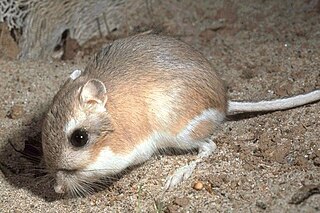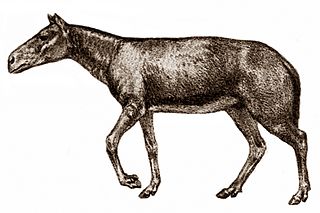
A fossil fuel is a hydrocarbon-containing material such as coal, oil, and natural gas, formed naturally in the Earth's crust from the remains of dead plants and animals that is extracted and burned as a fuel. Fossil fuels may be burned to provide heat for use directly, to power engines, or to generate electricity. Some fossil fuels are refined into derivatives such as kerosene, gasoline and propane before burning. The origin of fossil fuels is the anaerobic decomposition of buried dead organisms, containing organic molecules created by photosynthesis. The conversion from these materials to high-carbon fossil fuels typically require a geological process of millions of years.

Agate Fossil Beds National Monument is a U.S. National Monument near Harrison, Nebraska. The main features of the monument are a valley of the Niobrara River and the fossils found on Carnegie Hill and University Hill.

Geomyoidea is a superfamily of rodent that contains the pocket gophers (Geomyidae), the kangaroo rats and mice (Heteromyidae), and their fossil relatives.

Phlaocyon is an extinct genus of the Borophaginae subfamily of canids native to North America. It lives from the Early Oligocene to the Early Miocene epoch 33.3–16.3 Mya, existing for approximately 17.3 million years. It is closely related to Cynarctoides.

Hesperocyon is an extinct genus of canids that was endemic to North America, ranging from southern Canada to Colorado. It appeared during the Uintan age, –Bridgerian age (NALMA) of the Mid-Eocene– 42.5 Ma to 31.0 Ma. (AEO). Hesperocyon existed for approximately 11.5 million years.

Daphoenus is an extinct genus of amphicyonids. Daphoenus inhabited North America from the Late Eocene to the Middle Miocene, 37.2—16.0 Mya, existing for approximately 21 million years.

Eomyidae is a family of extinct rodents from North America and Eurasia related to modern day pocket gophers and kangaroo rats. They are known from the Middle Eocene to the Late Miocene in North America and from the Late Eocene to the Pleistocene in Eurasia. Eomyids were generally small, but occasionally large, and tended to be squirrel-like in form and habits. The family includes the earliest known gliding rodent, Eomys quercyi.

Kolponomos is an extinct genus of carnivoran mammal that existed in the Late Arikareean North American Land Mammal Age, early Miocene epoch, about 20 million years ago. It was likely a marine mammal. The genus was erected in 1960 by Ruben A. Stirton, a paleontologist at the University of California Museum of Paleontology, Berkeley, for the species K. clallamensis, on the basis of a partial skull and jaw found on the Olympic Peninsula. At the time, Stirton questionably assigned it to Procyonidae, its systematic position remained problematic until the discovery of more fossils including a nearly complete cranium from the original locality of K. clallamensis which helped identify it as part of the group from which pinnipeds evolved.

Herpetotherium is an extinct genus of metatherian mammal, belonging to the possibly paraphyletic family Herpetotheriidae. Native to North America from the Eocene to Early Miocene, fossils have been found in California, Oregon, Texas, Florida, Montana, Wyoming, Colorado, North and South Dakota, Nebraska, and Saskatchewan. The oldest species, H. knighti, is dated to around 50.3 mya, and the most recent, an unnamed species, may be as recent as 15.97 mya. A morphological analysis of marsupials and basal metatherians conducted in 2007 found Herpetotherium to be the sister group to extant marsupials. It is the youngest known metatherian from North America until the migration of the Virginia opossum from South America within the last 2 million years.
The Arikareean North American Stage on the geologic timescale is the North American faunal stage according to the North American Land Mammal Ages chronology (NALMA), typically set from 30,600,000 to 20,800,000 years BP, a period of 9.8 million years. It is usually considered to overlap the Oligocene and Miocene epochs. The Arikareean is preceded by the Whitneyan and followed by the Hemingfordian NALMA stages.

Archaeohippus is an extinct three toed member of the family Equidae known from fossils of early Oligocene to middle Miocene age. The genus is noted for several distinct skeletal features. The skull possesses deeply pocketed fossa in a notably long preorbital region. The genus is considered an example of phyletic dwarfism with adults estimated at being on average 20kg in weight. This is in contrast to the most common equid of the period, Miohippus. Characters of the teeth show a mix of both primitive and advanced traits. The advanced traits are very similar to those shown in the genus Parahippus. The noted similarities of Archaeohippus and Parahippus show them to be descended from a common ancestor and are considered sister species.

Proscalops is an extinct genus of insect-eating mammal. Formerly placed in the defunct order Insectivora, it is now placed with the Eulipotyphla. The first and most numerous Proscalops fossils were found in the Sharps Formation of South Dakota, near Wounded Knee. Other samples have been found in the Brule Formation of South Dakota, the Deep River Formation of Montana, and in Wyoming.

Merychyus is an extinct genus of oreodont of the family Merycoidodontidae, endemic to North America. It lived during the Miocene, 20.4—10.3 mya, existing for approximately 10 million years. Fossils are widespread through the central and western United States.
Phlaocyon achoros is an extinct species of the genus Phlaocyon, belonging to the subfamily Borophaginae and tribe Phlaocyonini, a canid which inhabited the southeastern North America from the Late Oligocene to Miocene living 24.6—20.8 mya and existed for approximately 4.2 million years.
Pliometanastes is an extinct genus of ground sloths of the family Megalonychidae endemic to North America during the Late Miocene epoch through very early Pliocene epoch. Its fossils have been found in Costa Rica and across the southern United States from California to Florida.
The Deep River Formation is a geologic formation in Montana. It preserves fossils dating back to the Neogene period.
Phlaocyon minor is an extinct species of canid mammal known from the Miocene-Oligocene of the United States

Crenatosiren is an extinct genus of dugongid sirenian known from the late Oligocene (Chattian) of Florida, North Carolina, and South Carolina. The type and only known species is Crenatosiren olseni.
Tephrodytes is an extinct genus of prehistoric frog known from Arikareean of Montana.
Corumictis is an extinct genus of mustelid from the Early Oligocene (Arikareean) of North America, specifically Oregon. It contains a single species Corumictis wolsani, which is notable for being the oldest currently known mustelid.












